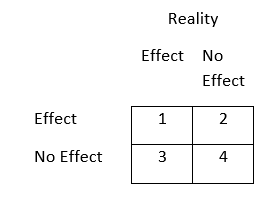Not Answered
You are conducting an experiment with group membership as your IV and attitudes toward Barack Obama as your DV, and you hypothesize that people in Group 1 will rate Obama higher than people in Group 2. In terms of the inferential statistical tests you would use to test your hypothesis, briefly explain the four possible outcomes that you could have regarding the correspondence between treatment effect and reality. In other words, use the variables above to describe the outcomes in each cell of the 2x2 matrix of treatment (effect/no effect) by reality (effect/no effect). (Be sure to label error types when appropriate).

a. You find that Group 1 rates Obama higher than Group 2, when in fact there was that effect present. This would be a correct conclusion, and the probability in which we will make this conclusion (given the presence of treatment and "real" effects) reflects the statistical power of the study.
b. 2. You find that Group 1 rates Obama higher than Group 2, but in fact there was no difference between groups in reality. This represents Type 1 error.
c. 3. You find that there was no difference in Obama's ratings between Groups 1 and 2 when in fact there was a difference present. This represents Type 2 error.
d. You find that there was no difference in Obama's ratings between Groups 1 and 2 when in fact there was no difference between groups. This would be a correct conclusion.
Correct Answer:

Verified
Correct Answer:
Verified
Q20: Hermione and Luna conducted a study on
Q21: Failing to reject the null hypothesis when
Q22: Briefly describe and compare internal and external
Q23: What are some of the advantages and
Q24: Whether the findings of a study can
Q25: What is the role of inferential statistics
Q26: All things being equal, compared to cross-sectional
Q27: In a (fictional) series of quasi-experimental studies,
Q28: Liana is writing a grant proposal for
Q30: The idea that researchers themselves can sometimes